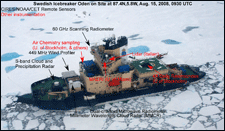Deployment of Arctic Summer Cloud Ocean Study
July 31, 2008
 Swedish Icebreaker Oden taken from NASA DC-8 Research Aircraft, August 15, 2008. Credit: Ron Wilcox |
Researchers from the NOAA Earth System Research Laboratories's Physical Sciences Division and the Cooperative Institute for Research in Environmental Sciences will participate in an international field experiment to better understand the atmospheric and chemical processes of how clouds affect the surface energy budget of the pack ice and its melting. The Arctic Summer Cloud-Ocean Study (ASCOS) has dual components, the first being deployment of surface-based sensors in the Arctic Ocean, near the North Pole, from August 1 – September 12, 2008 aboard the ice-breaker Research Vessel Oden. Measurements will be taken of cloud properties/processes, boundary layer structure/properties/processes, surface energy budget, and boundary-layer aerosol properties/sources. The second component involves six airborne missions during the month of August using a NASA DC-8 research aircraft. Aircraft measurements will focus on cloud structure, testing/validation of satellite retrieval techniques, and in-situ sampling of cloud microphysics, aerosol species, and size distributions.
ASCOS research is international and interdisciplinary, and encompasses marine biology, gas and aerosol chemistry, aerosol physics, oceanography, and meteorology. Stockholm University is coordinating the effort with groups from researchers institutions and universities in more than 10 countries.
Rapidly changing climate conditions in the Arctic pose serious biological and societal consequences in the Arctic and around the world. Better understanding of the processes affecting climate change in the Arctic can be applied to the global climate system and used to make projections for the future. This mission supports NOAA's goal to understand climate variability and change to enhance society's ability to plan and respond, as well as the cross-cutting priority of international cooperation and collaboration.
| Contact: Ola Persson | More Information: |